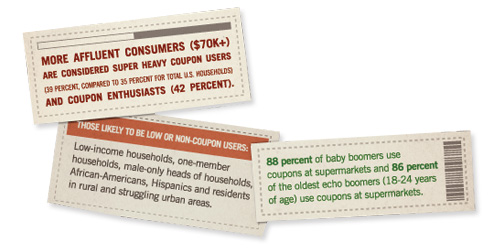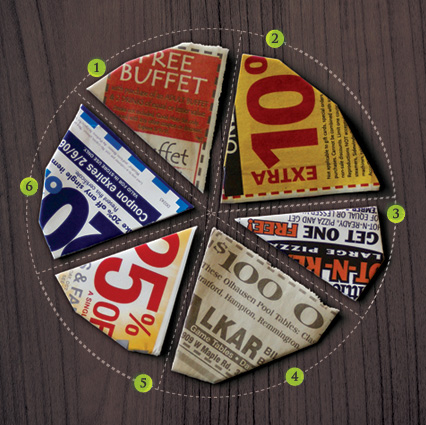April 15th, 2011
The Frugal Consumer
FRUGALITY — THE NEW NORMAL
Coupon usage records were set last year in the U.S. About 332 billion coupons were redeemed for a total value of $3.7 billion. Of all paper and paperless coupons, 87.7 percent were distributed via Free Standing Insert (FSI) formats, including co-op, solo and shared mail. The second largest share was distributed via Handout In-Store media. Digital coupons saw a 37 percent increase in distribution and redemption.
THE PINCH
The consumer has experienced a major lifestyle shift over the past two years. Their day-to-day lives have been impacted by the economy, which leads them to spend serious time engaging with brands via coupon advertisements. Today, the 81 percent of consumers consider themselves price-conscious, and 94 percent report using a coupon in the past year for a food, health and beauty, or household product.
Couponing is not easy. To do it right, you need time, patience and organization. You need to sift through papers and websites and go to multiple stores. You can join online couponing groups like ConsumerQueen.com to help manage daily deals, but this too requires a great deal of time. This can be difficult for anybody, let alone a family that’s just scraping by.
In an analysis of the shifts in consumer behavior and spending uncovered by the 2009 Booz & Company survey of 2,000 U.S. consumers, six statistically significant consumer segments emerged:
![]() SHOPPERS 2.0 16%
SHOPPERS 2.0 16%
The most technologically advanced of the survey sample, this segment shows the greatest tendency to buy online across categories. Its members are price sensitive, frequently use coupons and exhibit little brand or format loyalty.
![]() DEAL HUNTERS 21%
DEAL HUNTERS 21%
This segment is highly price-sensitive. Its members are heavy coupon users with low levels of brand or format loyalty. They are not inclined to buy products online; they direct their price-focused online research to getting the best deal in the store.
![]() ONLINE WINDOW-SHOPPERS 11%
ONLINE WINDOW-SHOPPERS 11%
This segment conducts a high level of research online but is less likely to purchase online. Its members exhibit a more modest degree of price sensitivity and brand switching than Shopper 2.0 and Deal Hunters.
![]() CHANNEL SURFERS 20%
CHANNEL SURFERS 20%
People in this segment are the most willing to hunt for the brands they love and most likely to switch retail destinations to seek out those brands at favorable prices. Members of this segment are the most likely to trade off convenience to get good deals on the brands they want.
![]() LOYALISTS 15%
LOYALISTS 15%
This segment is the least likely to change brands and retail formats for reasons of price. Its members conduct research and buy online, often seeking to preserve their established brand preferences.
![]() LAGGARDS 17%
LAGGARDS 17%
This segment is the least likely to change brands and retail formats for reasons of price. Its members conduct research and buy online, often seeking to preserve their established brand preferences.
Article Sources: NCH Marketing Services, Valassis, Nielsen Media Research, Coupon Sherpa
April 15th, 2011
Right at Home
Between 76 and 78 million baby boomers across the United States are aging.
This group, the largest generation to date, will reach retirement age over the next two decades. In 2011, the first wave, the golden boomers, have begun to turn 65.
Aging boomers represent a huge opportunity for a variety of businesses, and many are positioning themselves for this transition. One such business is Right at Home, Inc. Right at Home is an international Omaha-based company whose franchises provide personal care and assistance to seniors and disabled adults in their homes. The company, founded in 1995, touts over 200 local, independent franchisees.
Right at Home knew that the aging boomers meant that even greater demand for its services was on the horizon. This necessitated a focus on brand positioning, messaging and strategic planning for the future. Right at Home enlisted Bozell to bring focus, clarity and consistency to the brand.
Bozell utilized its Branding From the Inside Out proprietary process to discover the magic inside the company and connect it with external audiences. It set the stage for a multi-faceted and coherent brand that will motivate and drive the business, and evolve over time.
Discovery is the first phase in the process. This phase researches internal and external audiences. Industry and trend analysis, and a corporate culture archetype survey were utilized. As a result, a couple of opportunities were identified. First, there was an opportunity to define the industry standard with the company’s strong commitment to care. Second, an opportunity existed to simplify the often overwhelming experience of finding in-home care by delivering information in a clear, concise fashion.
Next was an assessment phase. Internal and external communications and processes were carefully analyzed, and Right at Home asked itself the following “-able” questions: Is the positioning desirable? Obtainable? Useable? Sustainable? Portable? Brand promises for current customers, prospective customers and internal audiences were a result of this phase.
A five-year marketing plan was developed, beginning with a re-orientation phase to introduce the new brand. Brand ambassadors were developed through a corporate employee and franchisee task force. An extensive internal rollout followed that included all forms of electronic and print communications, employee meetings, franchisee meetings and presentations at national conferences. Bozell presented at many of these meetings and conferences. A detailed brand launch kit was distributed to each franchisee giving them all of the tools and resources they needed to introduce and implement the new brand, from presenting it to staff and contacts, to the tools to operate the business, such as an online ad builder.
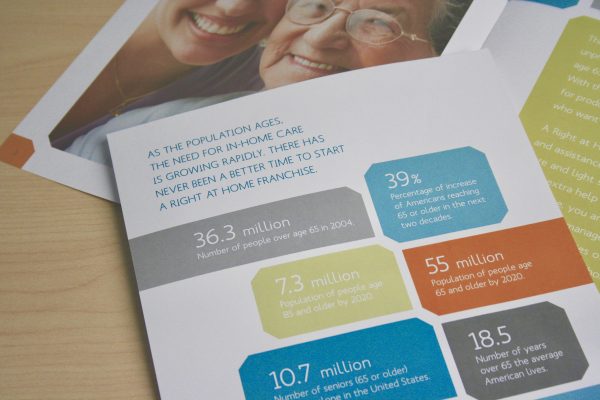
The internal launch was extremely well received. Right at Home saw record franchisee participation in webinars and collateral material orders, and the new brand guidelines and positioning were adopted with enthusiasm.
Simultaneously, a new website was launched as the first tangible consumer-facing element. The site was a complete custom solution tailored to the client’s exact needs. It features a Care Assessment to offer personalized information to family members and their loved ones, and provides powerful accessibility and customization of individual franchise websites. Custom content creation, organic search engine optimization and lead generation were important elements considered in the site development.
The website is showing a dramatic increase in site visits and significantly improved traffic over the previous year. Referrals to the website from search engines have increased and the site is also showing prominent organic search results for identified key words and phrases on Google.
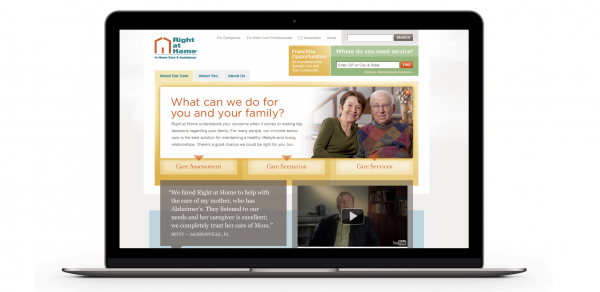
Much of 2010 centered on the assessment and re-orientation phases. The external launch phase of the marketing plan has only just begun. In 2011, the primary focus is online with strategic national partnerships with Caring.com and Oprah.com. Each major partnership engages a specific segment of Right at Home’s target audiences. Content development in the form of articles, blogs, expert advice, videos, banner ads and re-targeting are all a part of the overall plan for the coming year.
Initial results from the external launch are excellent and will continue to be monitored for the duration. Right at Home is building a brand that is contemporary and aspirational. It will simplify the customer experience both online and offline and will continue to differentiate the company from the pack of competitors.
*Ezine Articles, “Baby Boomers Begin Turning 65,” by Erica Goodstone, Ph.D
April 15th, 2011
It's a mad, mad, mad mobile world.
Mobile devices and tablet computers are changing the way we consume digital content. The boundaries of the television, desktop computer and laptop have been shattered by a whole new category of powerful devices. It should come as no surprise that most companies and even some pundits have been taken off guard by this monumental change.
While mobile phones have existed in one form or another since the ’80s, the past five years have transformed these devices. No longer is making calls the primary used function of these devices. Users are checking email, browsing the web, consuming news, reading books, listening to music and watching video programming all from their ultra portable smartphones. Morgan Stanley’s investment banking analysts predict that mobile Internet traffic will exceed computer Internet traffic by 2015.
Smartphone devices, coupled with the exploding category of tablet computers led by Apple’s iPad, is causing a huge shift in the way consumers access digital content. So much so that Apple’s competitors are playing catch-up. And the application of these devices goes beyond personal use. Forrester Research reported that 26 percent of iPad owners regularly use their devices for business-related activities.

Over the years, more desktop applications have been moving to web-based solutions. Applications such as Google Docs allow people to access and edit their documents from any computer with a web browser and an Internet connection. This is a monumental step forward for users, since they are no longer dependent on installed applications or local servers to access their information.
So it is interesting to note that in the mobile environment we are seeing a trend: These devices are application-centric as opposed to web-centric. Much of this comes from the current limitations of the devices and application developers’ abilities to create a strong user interface. The use of these devices and specialized applications has actually changed the way people access information. For example, the use of web-based email clients such as Hotmail, Gmail and Yahoo! Mail have actually decreased over the past year. People are now regularly checking their email through their mobile device and not relying on their computer for all email communication.
Up to this point, the application-centric model has worked well. App stores have brought in millions of dollars for companies like Apple, Research in Motion and Google, while allowing developers to make a profit as well. This trend will most likely hold for the foreseeable future.
How does this affect you as a marketer? Depending on your industry, your customers may already be looking for a marketing experience that has been optimized for their mobile devices. Here are some options:
Test your primary marketing website across various mobile devices and correct any obvious issues such as large uses of Flash animations or other images.
Consider your offerings and how a mobile-specific experience would be created to best navigate users through the content. With this type of experience, it is important to focus on the most important elements of your brand and potentially not include those more ancillary topics. This will greatly enhance the usability of the experience and avoid confusing users with unwanted content.
Determine if an application would benefit your organization or customers. You will need to identify the most likely platform, such as the iPhone, Android and Blackberry devices, and determine which you would like to develop for. It is important to understand that each is a different animal with a different structure and code base. You can’t just create an application for one platform and automatically publish it on another.
Do you have an online location where a lot of great information can be consumed? You can leverage simple QR codes and add them to your printed materials and other marketing pieces. This gives the user a convenient way to access online video and other content types without the need to manually type the web address into the mobile browser.
The types of marketing solutions that can be developed are only limited by your ability to solve user problems in the mobile environment. Obviously, there are basic rules that will need to be followed based on the platform you are developing and the types of devices and technologies your customer base is engaged with, but there is also tremendous opportunity. Don’t fear getting your feet wet, since your customers may very well have their toes in the water while watching your promotional video from their mobile device.
April 15th, 2011
Change for the Better
![]()
Sustainability is a term we’ve all heard used a lot lately in the press. While most often associated with environmental issues, the definition of sustainability goes beyond eco to include broader social issues, such as fair labor practices and other economic practices that impact production, consumption and disposal.
“We can’t solve problems using the same kind of thinking we used when we created them.” – Einstein
In study after study, consumers say they want to buy from companies they trust and respect. Companies that treat the environment well, are ethical and are socially responsible. And they have a growing toolset to gather information to aid in purchase decisions.
But historically, business and society have been pitted against each other to some degree in addressing issues like sustainability. This is in part because commonly held perceptions legitimized the idea that companies must sacrifice profits to provide societal benefits. This, in turn, pushed the responsibility to the consumer to seek sustainable choices, and they often paid substantially more in the process.
However, people and companies are beginning to think differently. Sustainability is emerging as a market driver and a way to differentiate a company or product, with the potential to grow profits and present opportunities for value creation — a pretty dramatic evolution from its traditional focus on efficiency, cost and supply chain risk.
The website GoodGuide.com provides a free iPhone app that rates and compares tens of thousands of products on their environmental, health and social impacts.
The companies that are responding to the new demands are prospering more than those that resist. In fact, some companies are truly doing well by doing good. Walmart is one such company. Many people love to hate Walmart, but as the 19th largest economy on earth (well ahead of Norway), what Walmart does affects and influences a significant number of companies and people.
A couple years ago Walmart launched its Sustainability Index (http://walmartstores.com/sustainability/9292.aspx), a three-phase plan that will ultimately create a label that would tell shoppers the environmental toll of every product it sells, from the greenhouse gas emissions to the water used. When, as part of its ambitious sustainability program, Walmart said it would sell only concentrated laundry detergent, which uses less packaging and water, manufacturers fell into line.
 Initiatives like this put pressure on all the manufacturers of products that sell to Walmart to look at their own practices. Can excess packaging be cut? Can more sustainable practices be put into place? They are looking because pretty soon it will be transparent to all of us and that could become a competitive differentiator.
Initiatives like this put pressure on all the manufacturers of products that sell to Walmart to look at their own practices. Can excess packaging be cut? Can more sustainable practices be put into place? They are looking because pretty soon it will be transparent to all of us and that could become a competitive differentiator.
Walmart also used its scale to drive the creation of new energy-saving technologies, such as LED freezer case lights, which are now commonly used by other retailers, and LED parking lot lighting. Both efforts saved Walmart millions. They also recognized the long-term economic benefits for customers by offering products that help them save on their utility bills, such as compact fluorescent light bulbs and more energy efficient televisions.
And recently, Walmart joined the fight against obesity. The company is reformulating thousands of products to make them healthier, and is pushing its suppliers to do the same. The company has committed to cut sodium in its products by 25 percent, added sugars by 10 percent, and to get rid of trans fats altogether over the next five years. Walmart has also committed to cut the cost of fruits and vegetables.
When you combine what feels like real momentum in the business sector with increasing consumer education and understanding, as well as efforts like that of Alex Bogusky’s COMMON, it seems like we are making progress towards solving some big problems. http://fearlessrevolution.com/blog/introducing-common.html
What are you doing?
![]()
April 15th, 2011
Return to Handmade

In a backlash against consumer culture, people are demanding products as unique as they are.
“If you go to Gap or Banana Republic, you are getting the same thing that someone in England is buying, or someone in the next town is buying, or someone in Southeast Asia is buying. There is no individuality anymore,” said Matthew Stitchcomb, vice president of marketing and communications for Etsy, an online venue with over 50K active sellers. In a world of mass-produced sameness, more and more people are craving the unique.
Skill and Craftsmanship
Those who opt for handmade items avoid the chaotic mall parking lots and chain store lines in favor of something more meaningful. They indulge themselves in the satisfaction of supporting an artist or crafter directly, honoring skill and craftsmanship, which are largely absent in the world of large-scale manufacturing.
Buying handmade may be a little more expensive than getting something that has been mass produced, but the quality of the finished product is often times better. Mass produced products are consistent with an intentionally shorter product lifespan. Products handmade by craftsmen are less likely to be built in a slipshod manner — 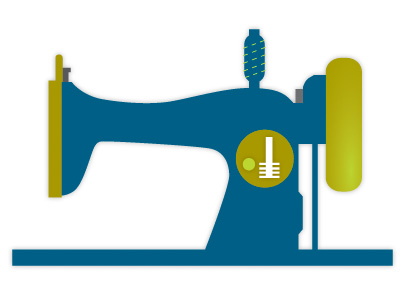 especially if the artisan has created an identifiable brand and the work itself becomes a legacy to the creator. These creations are lovingly made in a way that will last, benefiting both the consumer and the environment. Quality over quantity!
especially if the artisan has created an identifiable brand and the work itself becomes a legacy to the creator. These creations are lovingly made in a way that will last, benefiting both the consumer and the environment. Quality over quantity!
An example of growth:
January 2011 was the first time Etsy recorded over a billion page visits in a month!The $37.3 million of goods sold by the community in 2010 represents a 75% increase from 2009’s total. At the same time, items sold were up 62%.
Better for People
Our chain store culture, fueled by global manufacturing, has left us dressing, furnishing and decorating alike. We are encouraged to be consumers, not producers, of our own culture. Our ties to the local and human sources of our goods have been lost. Buying handmade helps us reconnect. Consumers are becoming increasingly aware of, and interested in, the source of things they buy, whether they want to buy with a conscience or to impress friends and acquaintances. Knowing who made something and where it came from adds value both to the product and the purchase.
 In certain instances eschewing the manufactured product is akin to heroism. “Just look at the news: lead recalls, sweatshop conditions in foreign factories, the loss of jobs in America’s heartlands. It has left a bitter, dehumanizing taste in the mouths of many consumers. And I think that’s a big reason why handmade is becoming so prevalent; it’s a rallying cry for us to bring the humanity back into shopping,” said Sion Lee, the founder of Indiepublic.com, a social network that caters to independent artists and designers.
In certain instances eschewing the manufactured product is akin to heroism. “Just look at the news: lead recalls, sweatshop conditions in foreign factories, the loss of jobs in America’s heartlands. It has left a bitter, dehumanizing taste in the mouths of many consumers. And I think that’s a big reason why handmade is becoming so prevalent; it’s a rallying cry for us to bring the humanity back into shopping,” said Sion Lee, the founder of Indiepublic.com, a social network that caters to independent artists and designers.
Kind to the Environment
The accumulating environmental effects of mass production contribute greatly to pollution of our air, water and soil. Until some of these problems are addressed satisfactorily, mass production continues to challenge our earth. With mass production increasingly being sourced to Asian countries, that “really cool” chair might have already racked up a sizable carbon footprint in its journey to the mall.
True cost
Everything contributing to the price of an artisan or handmade product is directly related to the time, elements and brand that made it without the additional markup associated with the many hands required to assemble and transport a mass produced item. For example, a blanket may have cost a dollar to make, but it is not inconceivable that by the time it travels overseas to the store display, it might retail for $30.
Don’t get me wrong. I love the Target experience as much as anyone. But I have found that as I make the transition to buying more local and regional handcrafted goods, my spending and consumerism decreases. My overall satisfaction with the items I have selected is far greater and they tend to last decidedly longer.
All images of Etsy were provided by Ty Cole from a photoshoot of the Etsy offices for his blog. Visit his sites at: www.tycole.blogspot.com + www.tycole.com
January 6th, 2011
Finding Your Way
Web Design Trends for Easier Site Navigation
One of the best things about designing and producing websites is the constant evolution of techniques and technology for doing so. We’re no longer constrained by tiny monitors with low resolutions, we’re close to being rid of incapacitated web browsers (sorry, IE 6) and the general public is familiar enough with using websites that we’re past the days of having to fully dummy-proof everything that’s put online. That being said, it’s still essential that when people get to your website they are able to find things. Easily. Quickly. Intuitively. If they can’t, they will leave.
Fortunately, there are some new trends in website navigation design that are making things better for everyone. Site visitors are able to quickly find what they are looking for with fewer clicks. There’s less ambiguity over what one link might mean versus another. It’s also more fun for those of us designing website navigation systems, as we can take observed visitor behavior and help solve navigation problems in new and exciting ways.
Trend #1: Descriptive Navigation Buttons
One significant new trend is giving site visitors larger, more descriptive navigation buttons. Since we have more screen real estate to work with, we’re able to use more of that space for communicating efficiently. Sometimes that means we can use more than one word for a navigation button. Say we have a button on a songwriter’s site labeled, “Discography.” It might make sense to people coming to your site, but the visitor has to make assumptions about what’s behind that button. Including supplementary descriptive text like, “Singles, Albums & Collaborations” helps tell a more complete story. Your visitor knows more about what they will be finding. They might have made assumptions about the content, but now they know more. And informed visitors have overall better experiences on websites.
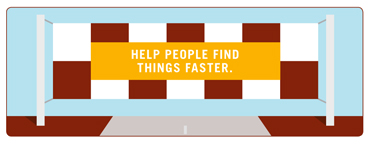
Trend #2: Mega Drop-Down Menus
Another trend that lets us put destination content in front of site visitors faster is what’s frequently referred to as a “mega drop-down” navigation menu. Drop-down menus have been around for a long time and are often used quite effectively. What a mega drop-down allows you to do is further design the layout and content of the drop-down menu. Instead of a simple list of links, a mega drop-down can employ images, text and even form elements in or
der to put the information the visitor seeks in front of them as quickly as possible. This can be incredibly effective in helping people find what they are looking for. Imagine an “Email Newsletter” menu that lets people select one of the most recent issues from an archive list or enter their email address to subscribe from right inside the menu. Everything is in context and the visitor is not required to go to another page to perform an important task.

Trend #3: Oversized Footers
The last trend we’ll look at can be seen on more and more sites every day. It’s the big footer. While there’s no agreed-upon terminology for it, everyone knows what it is. Website footers are no longer just a simple list of the site’s primary navigation, obligatory copyright information and a shameless plug for the developer. Site footers are now full-fledged resource centers. The benefit is apparent. Every visitor looks for things in different ways. Having a larger footer with more links to content, categorized in more ways that might be possible via standard navigation, can further help show people where to go. Some sites integrate sign-up and contact forms into the footer. Others have included photo slideshows or important news. Since it’s at the foot of the page, there’s no real loss of screen real estate. The visitor has already scrolled down and the expanded footer is a nice bonus that can help them get to a destination faster.
CONCLUSION
While there are a lot of other emerging trends and countless unique ways to let visitors navigate a site, these three website navigation trends stand out as markedly improving overall site usability and user experience. And when your visitors are trying to find something, faster is definitely better.
January 6th, 2011
Women Baby Boomers
We’re not who you think we are.
 How is today’s 50-something woman different from her sisters of bygone days? She has choices and she takes control. She has the power to decide how she wants to be treated and she exercises that power.
How is today’s 50-something woman different from her sisters of bygone days? She has choices and she takes control. She has the power to decide how she wants to be treated and she exercises that power.
The 50-something woman of two decades ago had ultimate power over laundry detergent and household cleaning products — as long as the results made her husband happy. Her 2010 counterpart is a key decision maker in corporate America and is often running the household finances as well. She has buying power and strong opinions. And she’s loyal when you treat her right. But she can still be quick to question herself and seek validation from respected advisors.
Stephen Reily is a very savvy marketer and creator of Vibrant Nation, a successful commercial website for women 50+. He also co-authored the new book Vibrant Nation: What Boomer Women 50+ Know, Think, Do & Buy with Carol Orsborn, Ph.D. Not long ago, Stephen was working on marketing an eggnog product for his client. A question was raised as to whether or not the product was too “stodgy” for the brand. The brand manager commented that even though their primary target audience were people between the ages of 21 to 29, this new product would reach their “most profitable and loyal customer,” the 50+ woman. That was a defining moment for Stephen.
Not only did marketers tend to ignore this valuable target group even when their value to the brand was evident, they relegated them to the “all things dowdy” category. These same marketers were clearly oblivious to today’s 50+ woman’s predilection for things that are trendy, hip or chic.
Having grown up around the strong and capable women who comprised his family, Stephen found these assumptions about 50+ women unsettling and inaccurate. He conducted a series of focus groups to find out what was really going on.
The focus groups confirmed that the reality of today’s 50ish woman was not the same as the frumpy but lovable All in the Family character, Edith Bunker. So why were marketers still treating these women as if they were about to sit down with a cup of hot cocoa and knit some afghans? As he continued to explore this previously uncharted territory, Stephen began to realize that marketers tended to confuse the 50+ woman with the senior market, a mistake not unlike confusing a nursery school child with a young woman preparing for her high school prom — do they both need strapless bras?
Was no one even trying to tap this valuable audience segment? 50+ women across the board confided to Stephen that present day marketing campaigns made them feel invisible. There was a collective dissatisfaction.
So how do you tap into this limitless potential? By recognizing that these women have an “innate gift for connectedness,” Stephen provided them with an online community, Vibrant Nation, which enabled and encouraged them to talk to each other. He created a “culture of commenting” and gave them a platform from which to laugh at themselves. Over a year after its launch, he still marvels at his followers’ eagerness to “dive in to help each other — no judgment.” Savvy marketers realized early on that this particular group of vibrant women were well worth the precious ad dollars, and many have flocked to run their ads on the Vibrant Nation site.
Sources-
BabyiDesign.com
January 6th, 2011
Cost Cutting in Business Journalism
The recession of 2009 has taken its toll on all of us, but for business journalism it greatly escalated the erosion that was already well underway.
Publishers are experimenting with new business approaches like pay-walls, paid mobile applications and hybrid editorial/ad models like Forbes’ AdVoice, but there is no widely agreed-upon model to restore the link between content and earnings.
It’s clear that companies and public relations professionals have to work much harder and smarter to persuade fewer reporters with less time, bigger workloads and more responsibility to take interest in what they have to say.
NEWSPAPERS
Daily circulation has dropped by 26% since 2000—from 55.8 million to 41.3 million
Revenue has decreased by nearly 50%—from $47.7 billion to $24.8 billion
Several newspaper groups have declared bankruptcy including: Tribune Company, Journal Register Company, Minneapolis Star Tribune, Philadelphia Newspaper LLC, Sun-Times Media Group and Freedom Communications, Inc.Newsroom workforce has decreased by 26%
USA Today laid off 9% of staff in Aug 2010.
Salt Lake City Desert News had a 43% staff reduction.
New York Times cut salaries and reduced staff by 8%.
Even the Wall Street Journal reduced staff.72 daily newspapers have disappeared since 2000
Closed, acquired or adopted an online hybrid model.
Most notable: Rocky Mountain News, Baltimore Examiner, Seattle Post-Intelligencer, Detroit News/Free Press and Christian Science Monitor.
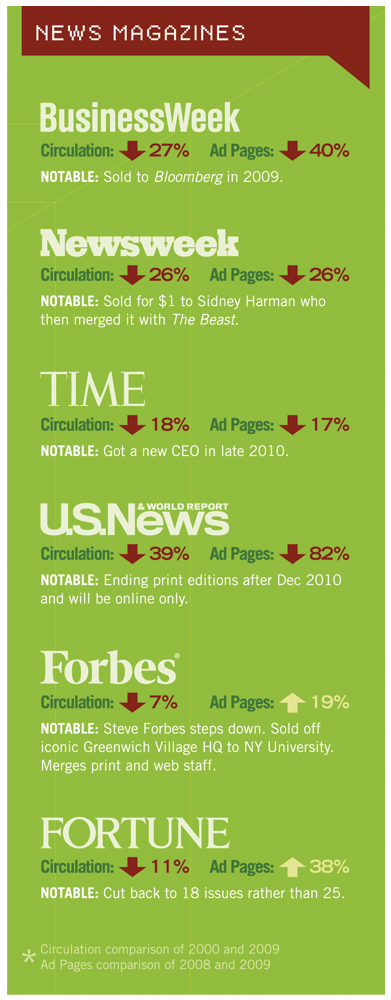
So what do you do?
Leverage online: Some publishers are now reserving material for online publication only. These are not lesser venues. In fact, many reach a wider audience than print publications.
Build media lists carefully: Do not spray and pray. Clarify where you are going and the publication’s focus before pitching.
Go non-traditional: Freelancers and working reporters now write blogs. Use them, but do your homework and make sure that the topic fits.
Do more advance work: Lay out the story and support it with facts. Line up materials, contacts and resources before contacting a journalist.
Write smarter pitches: Do more research, use sharper reasoning and write more compelling presentations of story ideas to reporters. Back claims with facts.
Have patience: With fewer and busier reporters, it may take much more time to cultivate relationships and generate interest in your story.
January 6th, 2011
Cheap Eats
How Red Mango Cashed in on the Budget-Friendly Snacking Trend
Post-recession consumer behaviors have shifted for the long haul. Instead of extravagant vacations and luxury services, people are going for smaller, more budget-friendly indulgences.
A CNN article, “How to get the most happiness for your buck,” recommends that consumers “go for quantity, not quality” when dining out because according to recent research, “the happiness you get from small and large purchases alike eventually fades.” AdWeek says people are following this advice, and restaurants across the country are modifying their menus to cater to a new group of snackers in “Luring Back Wary Diners.” As many as 52 percent of these consumers view snacking as a way to treat themselves and choose indulgent treats instead of healthy ones.
When Red Mango, the fastest growing frozen yogurt franchise, prepared to launch their first two locations in Omaha, they wanted to make the most of the opportunity.
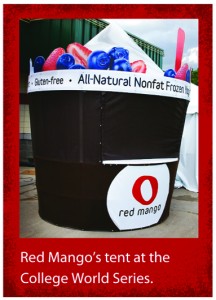 Red Mango wanted to build excitement and anticipation for its new locations. Bozell created a unique, yogurt-cup shaped tent, which Red Mango used to give out samples at the Men’s College World Series and O-Fest. The tent was eye-catching and built brand recognition. Each franchise was launched with an opening day celebration, including free frozen yogurt.
Red Mango wanted to build excitement and anticipation for its new locations. Bozell created a unique, yogurt-cup shaped tent, which Red Mango used to give out samples at the Men’s College World Series and O-Fest. The tent was eye-catching and built brand recognition. Each franchise was launched with an opening day celebration, including free frozen yogurt.
Bozell’s Smartargeting helped Red Mango develop a carefully targeted direct mailing to promote the grand opening celebration. The campaign was aimed at women, ages 20 to 54, living within a two-mile radius of the stores. A second mailing offered a coupon for the unique kosher treatment of Red Mango’s frozen yogurt to Omaha’s Jewish community.
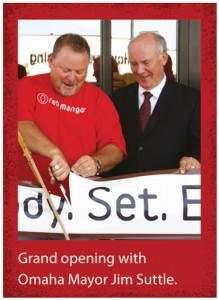 To announce Red Mango’s entrance into the Omaha market, Bozell worked with the Greater Omaha Chamber of Commerce to coordinate a ribbon cutting with Omaha Mayor Jim Suttle and other representatives and members of the Chamber. More than 3,200 attended the grand openings for free yogurt, live music and hot air balloon rides. Radio remotes from local radio stations aimed at Red Mango’s target audience helped spread the word about this new healthy alternative to other sweet treats. The ribbon cutting and grand openings received multiple mentions in the Omaha World-Herald, with additional coverage in local publications, radio shows and TV stations.
To announce Red Mango’s entrance into the Omaha market, Bozell worked with the Greater Omaha Chamber of Commerce to coordinate a ribbon cutting with Omaha Mayor Jim Suttle and other representatives and members of the Chamber. More than 3,200 attended the grand openings for free yogurt, live music and hot air balloon rides. Radio remotes from local radio stations aimed at Red Mango’s target audience helped spread the word about this new healthy alternative to other sweet treats. The ribbon cutting and grand openings received multiple mentions in the Omaha World-Herald, with additional coverage in local publications, radio shows and TV stations.
The careful planning and efforts to build hype paid off. Red Mango Omaha’s initial grand opening celebration was the most highly attended in the history of Red Mango. Red Mango positioned itself for a strong future with Omaha snackers.
Additionally, to enhance the user experience for Facebook fans of the Red Mango Omaha store, Bozell built the “My Mango” Facebook application. The application allows fans to create their own digital Red Mango treat, choosing from all the varieties of Red Mango flavors and toppings. Then, the application presents the final creation with a calorie count and the health benefits of the custom treat. The app then invites users to share the treats with their friends. In the first month since the launch, 367 different treats were created on the Facebook page.
January 6th, 2011
Check Out the Check In
Marketing Tips for Geolocation
 2010 was certainly the year for geolocation. Foursquare came to center stage, signing up 4.5 million users and counting, and Facebook added “Places” for its 500 million-plus users to check in to different locations.
2010 was certainly the year for geolocation. Foursquare came to center stage, signing up 4.5 million users and counting, and Facebook added “Places” for its 500 million-plus users to check in to different locations.
If you’re completely unfamiliar with geolocation networks, think of them as social media, but instead of users telling their friends what they’re doing, they’re sharing where they are.
The marketing opportunity for geolocation networks is simple. Tools like Twitter and Facebook are great for awareness and conversation, but geolocation tools like Foursquare, Gowalla, SVNGR and Facebook Places require action. Users must physically walk into a location in order to “check in.”
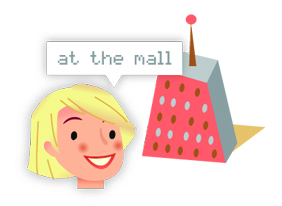 Both big brands like Gap, Starbucks and Macy’s, as well as little brands like your local sushi restaurant have jumped in to take advantage of this latest social media trend. While some of the marketing opportunities of geolocation are obvious, what’s not obvious is how to make it have an effective return for your business.
Both big brands like Gap, Starbucks and Macy’s, as well as little brands like your local sushi restaurant have jumped in to take advantage of this latest social media trend. While some of the marketing opportunities of geolocation are obvious, what’s not obvious is how to make it have an effective return for your business.
Here are some quick tips to get you on the right track for success.
Strategize_ For any portion of marketing to be effective, including social media, you need to have a thorough and detailed strategy. When creating a plan to implement geolocation for your business, first think about why you want to use this platform. What objective do you want to achieve? Who are you targeting? Which network makes the most sense for your audience? And, how can you track and measure results?
Activate_ “Claiming” your business is important regardless of which network you decide to use. Claiming your business allows you to edit the profile guaranteeing the accurate contact info and descriptions. Many platforms like Facebook Places and Foursquare allow venue managers to have access to an array to amazingly valuable analytics about who exactly is checking into your location.
Incentivize_ The sweet spot for geolocation tools is that they require user action. Although you may see some results from just adding your location or having an active account, give users a reason to check in to your location. Offer specials, promotions or rewards to incentivize your audience and encourage check-ins at a higher frequency.
Advertise_ Setting up a location and adding rewards, specials or deals is a great start, but you also need to create awareness. Use your other social channels like Twitter, Facebook, a blog, a newsletter and any other way you can think of to let people know you want them to check in and how to do it. Physical notifications like posters are also a great way to encourage activity and should be present in your location. Get creative!


